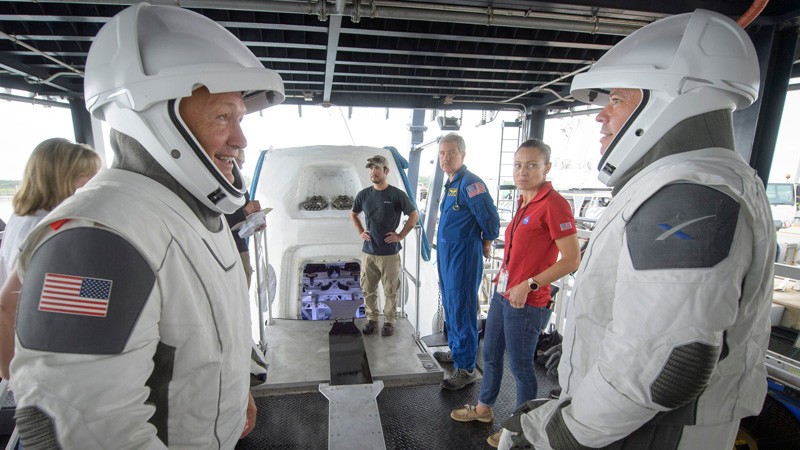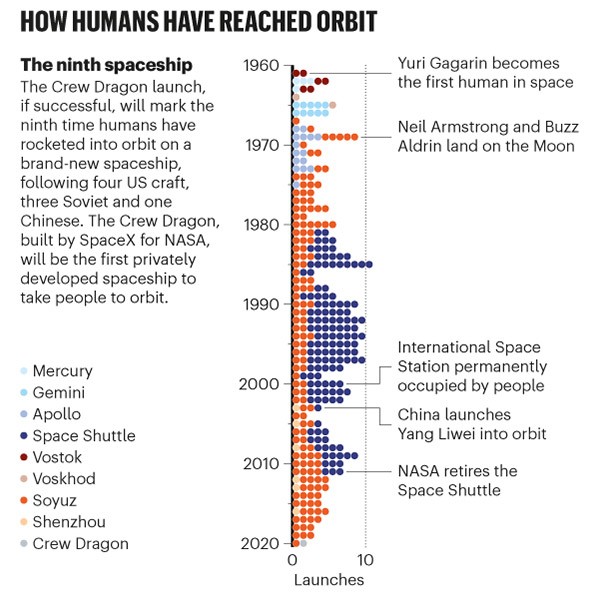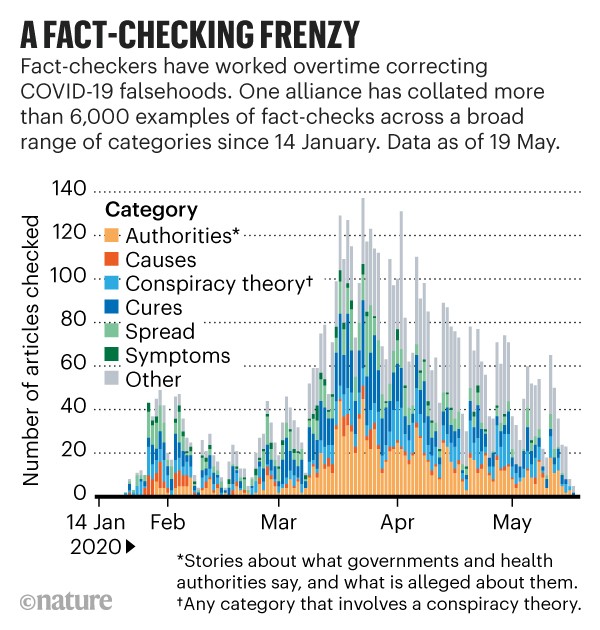Daily briefing: How scientific illustrators have made the coronavirus visible
Drawing the portrait of an invisible enemy, the epic battle against coronavirus conspiracy theories and a new era of human spaceflight starts today.
by Flora GrahamHello Nature readers, would you like to get this Briefing in your inbox free every day? Sign up here

Credit: Bill Ingalls/AP/Shutterstock
New era of human spaceflight starts today
If a SpaceX rocket launches as expected — at 20:33 UTC today, depending on the weather — it will be the first time a private company has put a human in orbit. It will also mark the first US launch of astronauts in almost a decade. Since the Space Shuttle retired in 2011, NASA — like all other space agencies — has relied on Russian Soyuz craft, originally designed in the 1960s, to take people to the International Space Station (ISS). SpaceX’s Crew Dragon capsule has been taking cargo to and from the ISS since 2019 — this flight just adds two humans, experienced NASA astronauts Doug Hurley and Bob Behnken. Fingers and toes crossed.

Mining company blasts ancient site
Mining company Rio Tinto has expanded an iron-ore mine to include a cave in Western Australia that was continually occupied for 46,000 years and is sacred to local Indigenous Australians. A dig in 2014 unearthed more than 7,000 artefacts and provided evidence that this was the only known site in inland Australia that was occupied throughout the last Ice Age. Burchell Hayes, director of the Puutu Kunti Kurrama and Pinikura Aboriginal Corporation, says the blasts might make it impossible to show future generations their links to their heritage. “We can tell them stories but we can’t show them photographs or take them out there to stand at the rock shelter and say: this is where your ancestors lived, starting 46,000 years ago.”
COVID-19 coronavirus outbreak

The epic battle against misinformation
As do epidemics, false information and conspiracy theories have their ‘superspreader’ moments. COVID-19 is “the perfect storm for the diffusion of false rumour and fake news”, says data scientist Walter Quattrociocchi. People are spending more time at home, and are searching online for answers to an uncertain and rapidly changing situation. “The topic is polarizing, scary, captivating. And it’s really easy for everyone to get information that is consistent with their system of belief.”
US outbreak started later than thought
The COVID-19 case that kicked off the first outbreak in the United States might have entered the country several weeks later than previously thought. That means the country potentially had a longer window of opportunity — which it missed — to prevent spread. Scientists initially thought that the February outbreak sprang from a single person who returned from Wuhan, China, on 15 January. New genetic studies, which have not yet been peer reviewed, show that case was an isolated one that was successfully contained. The cause of the larger outbreak was probably someone who came from any of several affected Asian countries or Canada in mid-February. “Everything is sort of lining up in the direction that if we’re serious about it, we can control this thing,” says Samuel Scarpino. “We’re just not being serious about it.”STAT | 6 min read
Reference: biorXiv preprint
A portrait of an invisible enemy
Scientific illustrators have made the SARS-CoV-2 virus visible, variously capturing its form, function and weaknesses. “Our editorial choices in colors and style emphasize the virus’s structural complexity and aggressive protein configuration, but also hint at its frail nature outside the body,” says illustrator Nick Klein. “With all the fear, death, and tragedy it has caused, it is not a living thing and has no capacity for malice … with perseverance and innovation, humanity can overcome this thing.”
Notable quotable
“Conservationists have seized the crisis as a chance to criminalise the ways of life of a large part of the world’s population. It reinforces the false divide between people and wildlife.”
Fiore Longo, who works with an organization that advocates for tribal peoples, offers one of various perspectives on the idea of banning the commercial trade of wild animals in response to the coronavirus pandemic. (The Guardian | 9 min read)
Features & opinion
How to map biochemical banter
Systems biologists are learning to build models of the intricate networks in communities such as the gut microbiome, where bacteria of some 1,000 different species both compete and collaborate with one another. Genome-scale metabolic models use gene sequencing to map thousands of interconnected biochemical reactions, involving many enzymes whose precise roles or structures are unknown. Trying to understand these relationships by analysing the chemicals they produce would be similar to guessing children’s snack preferences by what’s left on the table after a birthday party, says systems microbiologist Karsten Zengler. “You might observe the table and say, ‘Look at all those apples — that’s what children must like to eat.’ But that is not the case.”
Quote of the day
“Robinson helped to bring rationality into a field in which emotions often run high.”
Julian Perry Robinson, a chemist and lawyer who shaped international weapons conventions, died on 22 April, aged 78, from complications of COVID-19. His former student and colleague Caitriona McLeish pays tribute to his influential contribution. (Nature | 5 min read)
I’ll be glued to NASA Television later watching — weather permitting and fate willing — astronauts Doug Hurley and Bob Behnken travel to the ISS.
While we wait with bated breath, here are guaranteed soothing views: a Eurasian eagle-owl, Europe's biggest owl species, is raising three huge fluffy chicks in a nest in this fellow’s window box.
This newsletter is always evolving — tell us what you think! Please send your feedback to briefing@nature.com.
Flora Graham, senior editor, Nature Briefing
With contributions by Davide Castelvecchi and David Cyranoski